Villa "De Wormshoef Lunteren" |
The Wormshoef, the place of horror |
 |
| Villa De Wormshoef built in 1909 |
| Villa De Wormshoef served as a place for the Sicherheitsdienst (the SD) during the war years '44 -'45, Dutch collaborators who were employed by the SD and their German bosses there at that time practiced the most terrible torture practices on both men and women, sometimes resulting in death, almost all have been convicted of war crimes, and some of them have been sentenced to death and have been executed. |
 |
| Heinrich Ludwig Heinemann (Born te Wuppertal, 2 januari 1911 - Executed February 10, 1947 Arnhem, the Netherlands |
Second World War '40 - '45 |
| In 1944, as a result of the Battle of Arnhem, a large stream of evacuees started. The Wormshoef was used as a reception location, but around 19 November 1944 the Sicherheitsdienst (SD) came to Lunteren and the villas De Wormshoef, and also D'Eekhorst, were demanded. The evacuees were put on the street and the cellar of De Wormshoef was set up as a prison. Many resistance fighters, illegal immigrants, people in hiding and work refusers were imprisoned here. The Wormshoef was notorious for the cruel torture practices that took place there. The people who worked here included Ludwig Heinemann (1911-1947) (all in Dutch laguage), Ries Jansen, Arno Huhn, Johnny de Droog and Friedrich Enkelstroth, among others. On April 14, 1945, the day before the liberation, the SD left for Amersfoort. The light prisoners were left behind, the heavy cases were taken away. Lunteren was liberated on 15 April 1945 by the Canadians. De Wormshoef got a direct hit from a Canadian tank. The Wormshoef was subsequently used as a prison for war criminals for a short time and afterwards it was again converted into a home for several families and later in 1956 it became a Hotel annex restaurant, see elsewhere on this page. |
The failed weapon dropping |
| In the night of 8 to 9 March 1945, the Germans arrested the Bennekom resistance fighter Bart van Elst after a failed dropping of weapons at Lunteren on the De Keuenklep. van Elst and nine other members of the resistance will be shot later that month, with the liberation in sight, in Camp Amersfoort on the Appelweg, see further the images of several fusilla sites and memorials. The Germans intercept the dropped containers, see pictures below Resistance fighter Bart van Elst, who had been wanted by the Germans for some time, is arrested and taken to Camp Amersfoort. There he is shot on March 20, after a time of interrogations and serious assault. van Elst was a member of the Marechaussee (Military Police) that was brought under the control of the Germans after the occupation. He was stationed in the barracks of the Groesbeek brigade, he was arrested in May 1942 after singing the National Anthem "Wilhelmus" together with a number of colleagues in Nijmegen. van Elst is taken to camp Amersfoort and then to Germany for 18 months of forced labor, if he has to go back to Arnhem in that period to testify in a court case, he decides to go into hiding and report to the resistance in Bennekom.(for pictures from that dropping look further below) |
| Shaved head to prevent recognition and his front teeth out. In March 1944 he is still recognized and arrested, but he manages to escape again. To make recognition difficult, he gets shaved and gets a gray wig and also his two protruding front teeth are also pulled, van Elst can move forward again but is in the wrong place at the wrong time at the night of 8 to 9 March 1945 when a weapon drop goes wrong at Lunteren for the resistance. Executions Together with 14 other members of the resistance of the Ede group of the Interior Forces, he is arrested and taken to Camp Amersfoort. There he ends up in a detention center for death row inmates/candidates and is severely abused. Together with 9 other prisoners, he will be shot on the Appelweg in Amersfoort on March 20, 1945. The reason is the liquidation by the resistance of a collaborated police officer Diederik Lutke Schipholt (Hengelo, 9 april 1916 - Amersfoort, 14 maart 1945) Lutke Schipholt was shot in the back in the afternoon ± 4.45 pm by resistance fighter J.A. van Dam on March 14, 1945 in the Westerstraat, while he was cycling there with Maria Frederika Buwalda, he had already died of his injuries upon arrival at the hospital. For that act of resistance, another 10 hostages are being shot in Loosdrecht, including six from the municipality of Ede. They were all involved in the failed arms dropping on the night of March 8, 1945, these were: Rijk Tigelaar (32 years, Ede), Cor Garritsen (23 years Ede), Cornelis Verduijn (37 years Ede), Hylke van Vliet (27 year Bennekom), Fokke Roosjen (32 year Ede) Piet Roseboom (25 year Bennekom) |
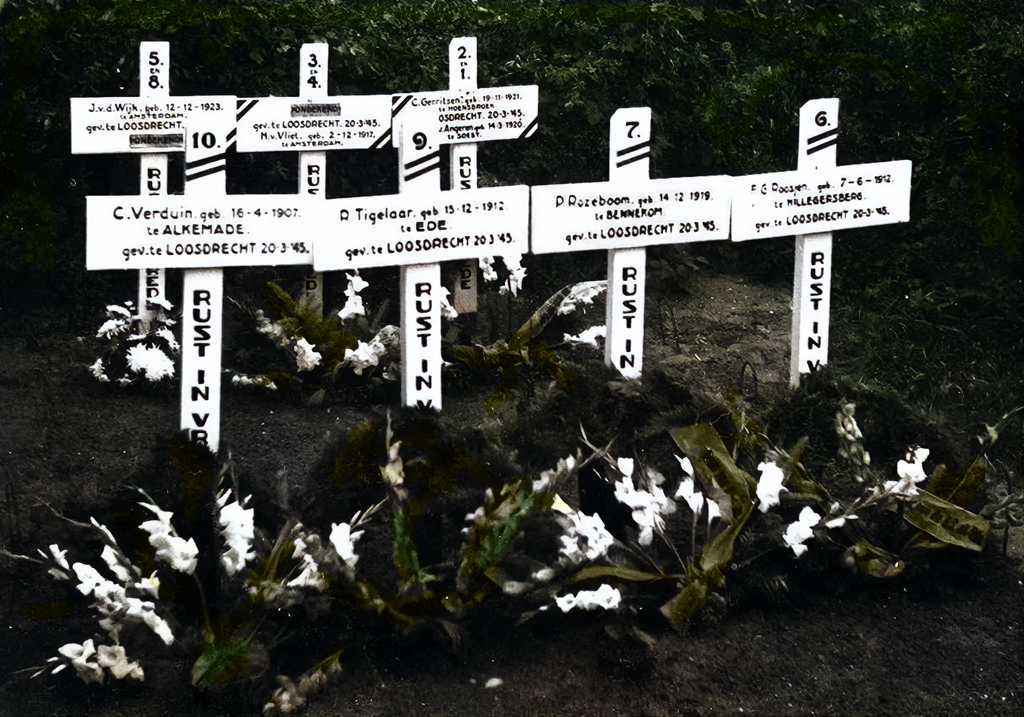 |
| On March 20, 1945, ten men were shot by the Germans opposite the former town hall of Loosdrecht as a reprisal for the shooting of a German under officer on Saturday evening on Saturday evening March 17, 1945. |
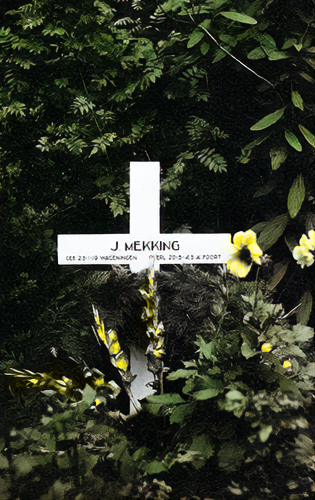 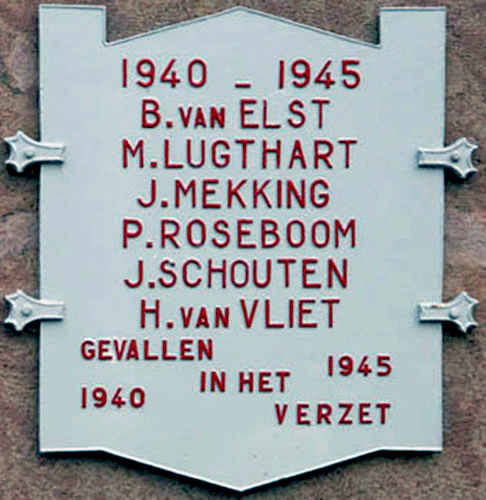 |
 Kelderman (1919-1945).jpg) 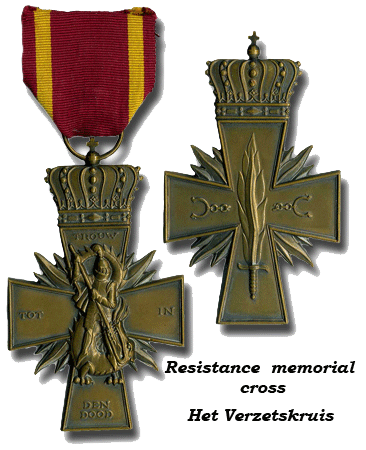  |
| Johannes (Jo) Kelderman (1919-1945) |
| Johannes (Jo) Kelderman (Ede, January 11, 1919 - Amersfoort, March 20, 1945) was a Dutch resistance fighter in World War II.
He was executed because of his involvement in a weapon drop near Lunteren. Kelderman was a member of the Domestic Forces in Lunteren, which was led by Driekus van de Pol and Aart Roelofsen. He was one of the guides during Operation Pegasus I, in which a large group of British soldiers who after the lost Battle of Arnhem sneaked through the German lines and crossed the Rhine. He was also a contact person for the illegal magazine "De Eendracht" (Get'em out: Pegasus I and II) A weapon drop took place on the night of 2 March 1945 in the fields between Ede and Lunteren. A few days later, England was asked whether it was safe to do another dropping in the same place. That was not the case, because after the dropping seventeen of the participants in the dropping were arrested. Several of the arrested were from the resistance group from Lunteren. Some. if not almost all of them came into the hands of a group of SD people who had their headquarters in the Villa De Wormshoef, a terrible place where people were seriously mistreated and tortured. In the morning it was clear to the leadership of the resistance in Lunteren that something had gone wrong, but not exactly what. Kelderman was therefore sent for investigation. Near the Immenweg he was arrested by the Germans still present who suspected him of being involved in the arms drop. The "Ausweis" (identification card) that he showed to be able to move freely on the street was immediately recognized as false. The decisive factor to arrest it was the so-called Tommy cardigan that he was wearing. Kelderman was transported by farm wagon to De Wormshoef, the regional headquarters of the Sicherheitsdienst. His guards stopped at the bakery to buy bread. He did not respond to a call from Breunis ten Ham, a member of the Lunters resistance, to escape. He may have thought that the Germans could not make him anything because they could not prove that he had anything to do with the dropping. That was very naive of him to think that with all the consequences that entails, this decision was fatal, all arrestees were transferred to Camp Amersfoort a few days later. On March 14, 1945, the "collaborating" police officer Diederik Lutke Schipholt was shot dead in Amersfoort by the resistance, as a retaliatory measure, Kelderman was shot six days later together with nine others at the Appelweg in Amersfoort. Kelderman lived in Meulunteren. After the war, Kelderman's body was added to Het Mausoleum in Ede. He received the Resistance Memorial Cross posthumously. |
The failed arms drop on the night of 8 to 9 March 1945 |
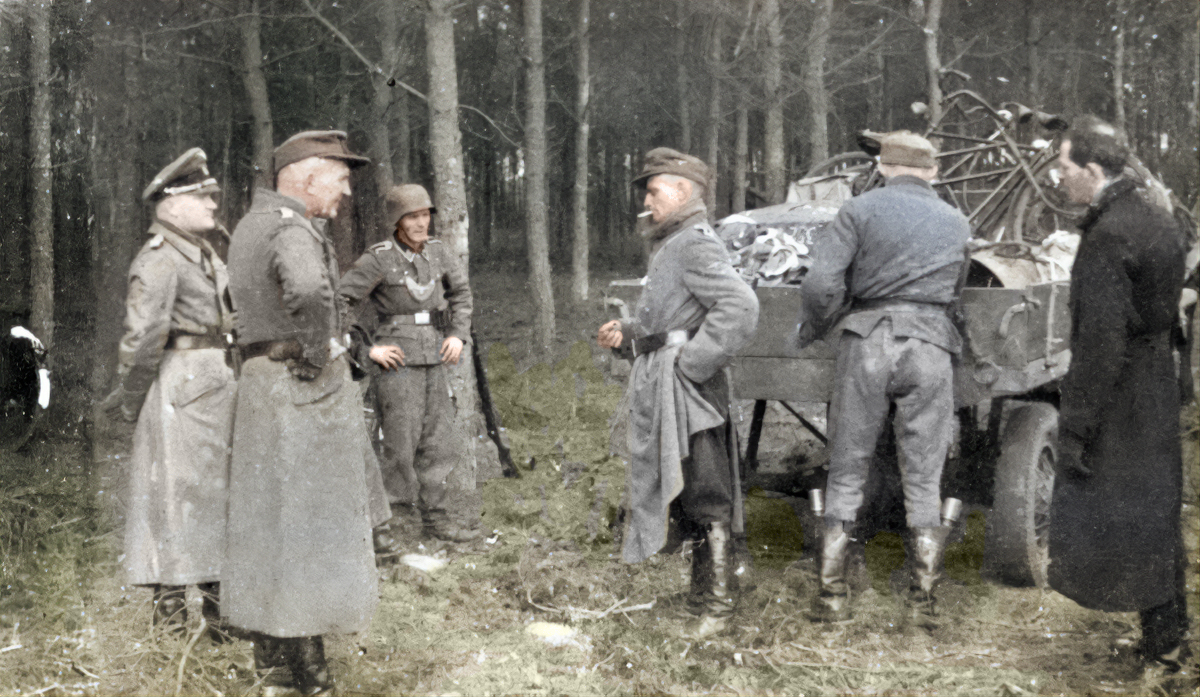 |
| Germans on the dropping site, where they put a heavy blow to the resistance in the municipality of Ede.
Many arrested members of the resistance had to pay for it with their lives. |
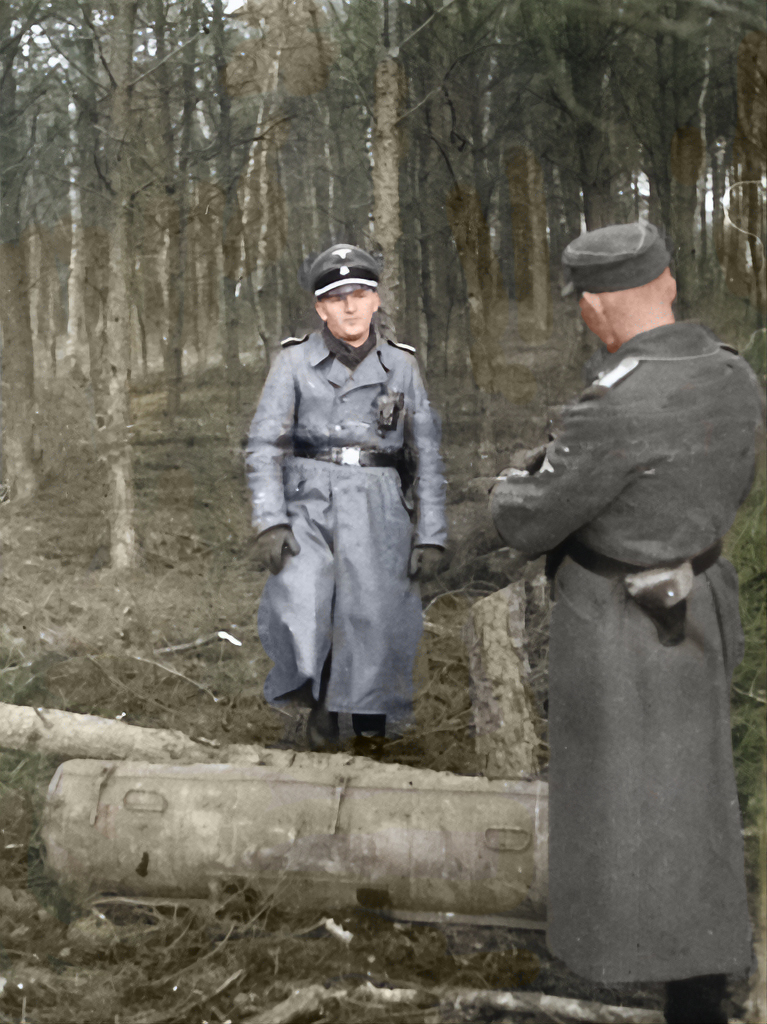 |
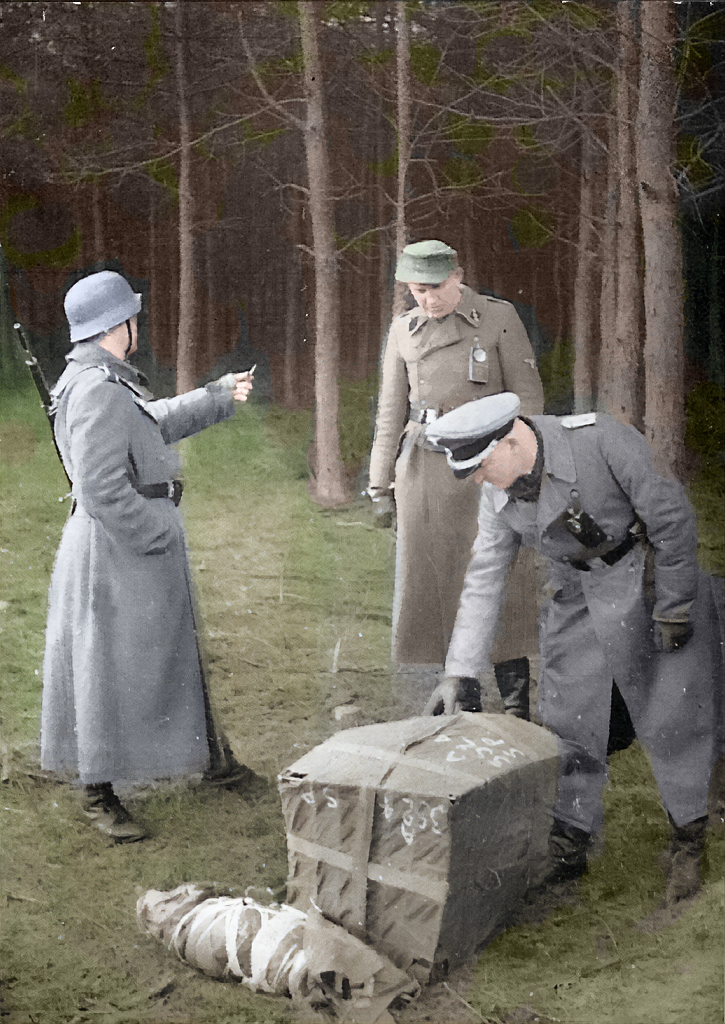 |
| Germans on the dropping zone in Lunteren, province of Gelderland |
 |
| During the night of 8 to 9 March 1945, various resistance fighters or helpers were arrested, some of whom were later shot in retaliation in Camp Amersfoort on the Appelweg. |
| Liberation of Lunteren by the Canadians on April 17, 1945 |
| A Canadian tank in the center of Lunteren during the liberation on April 17, 1945 |
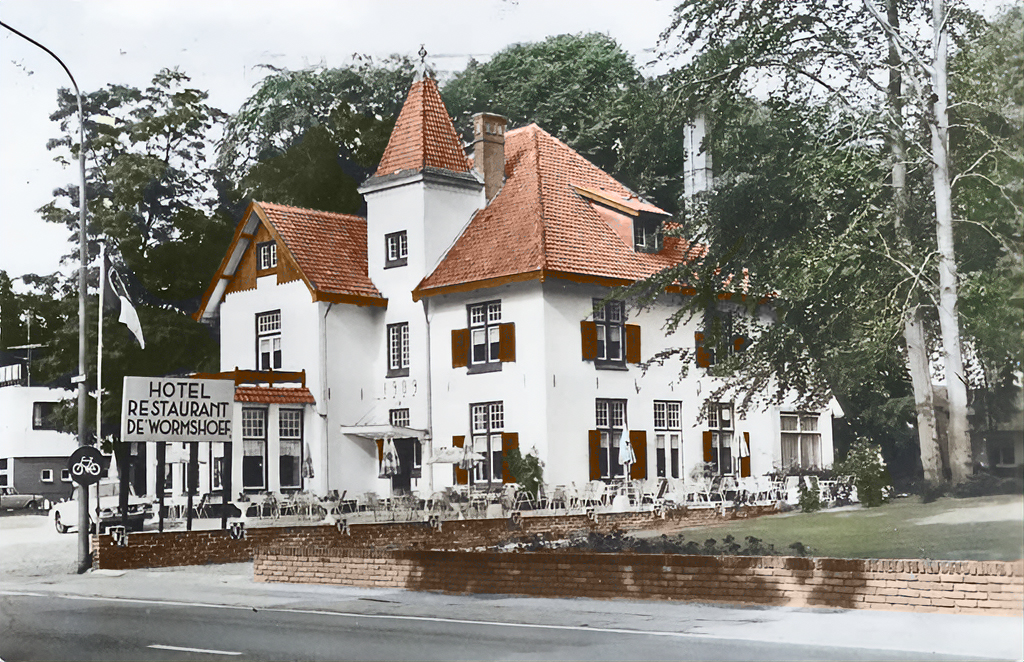 |
| De Wormshoef has been a Hotel restaurant since 1956, photo dating back to ± 70s |
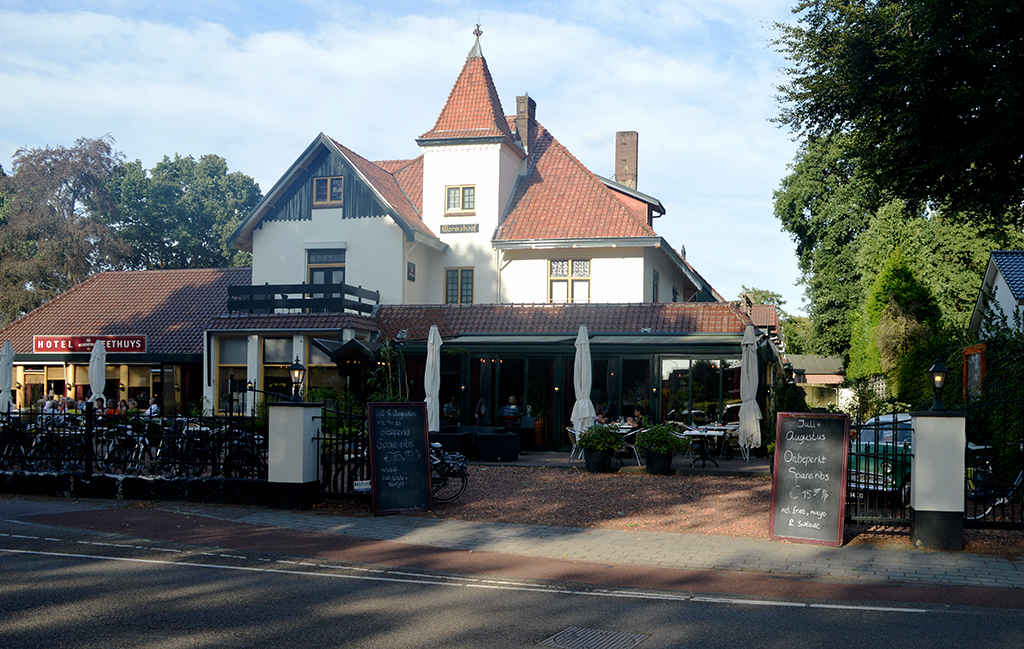 |
| The Wormshoef today |
     |
| English translation and editing by the The Ancestor Company All rights reserved, Sources: Omroep Gelderland and Wikipedia Thanks to various archive institutions for making certain images and facts available. Copyright © Genealogybos.com 2024 |